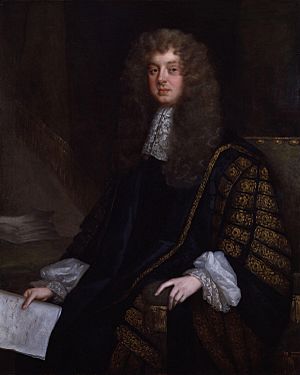Sir Edward Seymour, 4th Baronet facts for kids
Quick facts for kids
Sir Edward Seymour
|
|
|---|---|
 |
|
| Speaker of the House of Commons | |
| In office 1673–1679 |
|
| Preceded by | Job Charlton |
| Succeeded by | William Gregory |
| Treasurer of the Navy | |
| In office 1673–1681 |
|
| Preceded by | Sir Thomas Osborne |
| Succeeded by | The Viscount Falkland |
| Personal details | |
| Born | 1632 |
| Died | 17 February 1708 |
| Spouses | Margaret Wale Laetitia Popham |
Sir Edward Seymour, 4th Baronet (born 1632 or 1633 – died 17 February 1708), was an important British nobleman and politician. He was a Royalist (meaning he supported the King) and a Tory (a political party). He came from Berry Pomeroy and was a Member of Parliament (MP).
Contents
Early Life and Political Beginnings
Growing Up in Devon
Edward Seymour was born at Berry Pomeroy Castle in Devon, England. His family was very powerful in the western parts of the country. He was the oldest son of Sir Edward Seymour, 3rd Baronet, and Anne Portman. His family was directly related to Edward Seymour, 1st Duke of Somerset, a very famous historical figure.
First Steps in Parliament
Sir Edward Seymour first became a Member of Parliament in 1661. He represented Hindon in Wiltshire. This area was close to Bradley House, where his family lived. Later in his life, he represented other areas like Devon, Totnes, and Exeter.
A Powerful Political Career
Becoming Speaker of the House
Sir Edward was a very good debater and politician. He was chosen twice to be the Speaker of the House of Commons. This was during a time known as the Cavalier Parliament. He was the first person in a long time who was not a lawyer to hold this important position.
Key Government Roles
He held several important jobs in the government. From 1673 to 1679, he was one of the Lords Commissioners of the Admiralty. This group helped manage the navy. He also served as Treasurer of the Navy from 1673 to 1681. This role involved managing the navy's money.
Later, he became a Privy Counsellor in 1679. This meant he advised the King. He also worked as a Lord Commissioner of the Treasury from 1690 to 1696. From 1702 to 1704, he was the Comptroller of the Household. This role involved managing the royal household. He also played a part in the creation of the Habeas Corpus Act 1679. This law protects people from being held in prison without a good reason.
His Character and Influence
Sir Edward Seymour was very capable, but he was also known for being very proud of his family's history. He was a powerful leader in Parliament and had many supporters from the western counties. He was a strong supporter of the Tory party. He opposed the Exclusion Bill, which tried to stop the King's brother, James, from becoming king.
Even though some people found him arrogant, his influence was highly valued. He was a loyal friend to those he trusted. For example, he strongly defended his friend Sir Richard Reynell, 1st Baronet, when he was accused of a serious crime.
Facing Political Challenges
Sir Edward continued to oppose King James II when the King made unfair decisions. During the Glorious Revolution, he was one of the first Tories to support Prince William of Orange. There is a famous story about their first meeting. Prince William said, "I think, Sir Edward, that you are of the family of the Duke of Somerset." Sir Edward proudly replied, "Pardon me, your highness, the Duke of Somerset is of my family."
He remained a strong Tory and often spoke out against the Whig party. He tried several times to remove Lord Somers, the Chancellor, from his position. After his third son died in a duel, he spoke out against the idea of a large standing army.
Later Years
In his later life, Sir Edward Seymour seems to have suffered from diabetes. He died at his home, Bradley House, on 17 February 1708.
Family Life
Sir Edward Seymour was married twice and had several children.
First Marriage
On 7 September 1661, he married Margaret Wale. She passed away before 1674. They had two children together:
- Sir Edward Seymour, 5th Baronet (1663–1741), who later became the father of Edward Seymour, 8th Duke of Somerset.
- Lt.-Gen. William Seymour (1664–1728), who became a high-ranking army officer.
Second Marriage
In 1674, he married Laetitia Popham. She passed away on 16 March 1714. They had seven children:
- Col. Popham Seymour-Conway (1675–1699), who died young.
- Francis Seymour-Conway, 1st Baron Conway (1679–1732), who was the father of Francis Seymour, 1st Marquess of Hertford.
- Charles Seymour, who lived in Dorset and had a daughter named Jane.
- Jane Seymour married Admiral Thomas Lynn in August 1750.
- Anne Seymour (died 10 May 1752), who married William Berkeley in 1707 or 1708.
- Henry Seymour, who died without having any sons.
- Alexander Seymour, who also died without having any sons.
- John Seymour, who died when he was very young.

